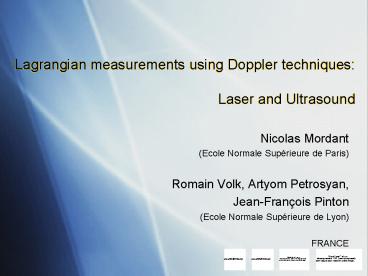Lagrangian measurements using Doppler techniques: Laser and Ultrasound - PowerPoint PPT Presentation
1 / 23
Title:
Lagrangian measurements using Doppler techniques: Laser and Ultrasound
Description:
Lagrangian measurements using Doppler techniques: Laser and Ultrasound. Nicolas Mordant ... (heterodyne detection) 10 liters of water, 2x 1kW motors. 250 m particles ... – PowerPoint PPT presentation
Number of Views:112
Avg rating:3.0/5.0
Title: Lagrangian measurements using Doppler techniques: Laser and Ultrasound
1
Lagrangian measurements using Doppler
techniquesLaser and Ultrasound
- Nicolas Mordant
- (Ecole Normale Supérieure de Paris)
- Romain Volk, Artyom Petrosyan,
- Jean-François Pinton
- (Ecole Normale Supérieure de Lyon)
- FRANCE
2
Experimental goals in Lagrangian measurements
- Track individual particles along their
trajectories - - single out individual particles
- - field of view as wide as possible
- Measure trajectories for long enough to have
information about the dynamics - - acceleration time scale Kolmogorov time ??
- - velocity integral time scale TL
3
Experimental Issues for Lagrangian measurements
(I)
values for ?20 W/kg, ?1 m/s, ?10-6m2/s
- Temporal resolution
- Lab experiment in water
- Spatial resolution
- in water
- Integral scales
- time (3ltC0lt7)
- space several centimeters
4
Experimental Issues for Lagrangian measurements
(II)
- for Doppler measurements no direct spatial
sampling - spatial localization imposed by the measurement
volume
the whole difficulty lies in the temporal
resolution
either small measurement volume or homogeneous
turbulence
5
Experiments in LyonKLAC KLOP
- old ultrasound Doppler experiment (KLAC)
- preliminary laser Doppler experiment (KLOP)
- same physical principle
- same flow French Washing Machine
- different time resolution
- Doppler frequency shift for 1 m/s
- acoustics 2.5 kHz laser 50 kHz
- ( big particles 250 ?m)
- different measurement volumes
- typical size
- acoustics 10 cm laser 3 mm
6
Experiments in LyonKLAC
- emission at 2.5 MHz
- angle between beams
- 45 degrees
- equivalent fringe length 0.85 mm
- direct sampling of the acoustic wave
- (heterodyne detection)
- 10 liters of water, 2x 1kW motors
- 250 ?m particles
- typical size of the measurement volume 10 cm a
the center
Mordant, Lévêque Pinton, NJP 2004
7
Experiments in LyonKLOP
- laser 1W splitted into two beams
- angle between beams
- 1.5 degrees, fringe length 20?m
- sampling of the light intensity
- 5 liters of water, 2x 600W motors
- 10 ?m fluorescent particles
- typical size of the measurement volume 3 mm a
the center - so far measurement of the absolute value of the
velocity only - (addition of acousto-optic
modulators soon)
PM
telescopes to increase the beam size
8
the frequency demodulation (1)
goal extract the spectral component with the
best time resolution
example time-frequency picture of a laser signal
high acceleration (200 g)
9
the frequency demodulation (2)
Fourier analysis blind approach (no a priori
information on the signal) uncertainty principle
for an accuracy of 0.05 m/s and 0.2 ms in our
configuration for ultrasound for laser
parametric approach add a priori information on
the structure of the signal
10
the frequency demodulation (3)
the noise is assumed to be white gaussian of
variance ?b2
the likelihood of the parameter set An, fn ,
?b2, N is thus
one has to maximize the likelihood to get the
optimal parameters BUT not possible
analytically one can maximize analytically in
respect with the amplitudes at fixed frequencies
and noise variance
Mordant, Pinton Michel, JASA 2002
11
the frequency demodulation (4)
- ?b is estimated separately
- N is postulated (N1 in general)
- An(t) are estimated from the frequencies
- fn(t) are estimated from a second order
approximation of the likelihood in the vicinity
of its maximum (requires a first estimate) - the overall estimator is embedded in a Kalman
filter (prediction/correction scheme) to get a
tracking algorithm - the algorithm outputs the Hessian of the
likelihood which gives the confidence in the
estimation
12
the frequency demodulation results (1)
13
the frequency demodulation results (2)
14
the frequency demodulation results (3)
distribution of recorded events
15
the frequency demodulation results (4)
no dependence of the acceleration variance on the
length of the recorded events (less bias than for
the velocity?)
16
Velocity distribution (KLOP)
preliminary results from the Laser experiment
(only 2.105 data points) (only the absolute
value of the velocity so far) Gaussian
distribution of the velocity with vrms0.3
m/s ?25 W/kg (?), R?100(?)
17
acceleration PDF (KLOP)
arms400 m/s2 compatible with Heisenberg-Yaglom
with a02 (Vedula Yeung) and ?25 W/kg
solid line Bodenschatz data R?285
18
acceleration correlation (KLOP)
zero crossing at 1.6 ?? ??Yeung Pope report
2.2?? at R?90)
19
perspectives of the KLOP experiment
- improve the signal over noise ratio
- (larger fluo. particles or higher reflectivity
particles) - increase the amount of data
- increase the Reynolds number
- more powerful laser (larger measurement volume)
- other kind of particles (inertial, different
sizes)
20
results from the KLAC experiment (1)
large measurement volume velocity autocorrelation
Mordant, Metz, Michel Pinton PRL 2001
21
results from the KLAC experiment (2)
Kolmogorov constant C0
with
here C04 at R?800
important for stochastic modelling of dispersion
22
results from the KLAC experiment (3)
ai surrogate for the acceleration magnitude
long time decorrelation integral time
Mordant, Lévêque Pinton, NJP 2004
23
results from the KLAC experiment (4)
velocity time increments
intermittency
Mordant, Metz, Michel Pinton PRL 2001































